| Columns Retired Columns & Blogs |
HRT Music Streamer+ USB D/A Converter Measurements
Sidebar 3: Measurements
I examined the measured behavior of the Music Streamer+ using the Audio Precision SYS2722 system (see www.ap.com and "As We See It" in the January 2008 issue), as well as, for some tests, my Audio Precision System One Dual Domain and the Miller Audio Research Jitter Analyzer. I drove the Music Streamers with the USB 2.0 output of my Intel MacBook running OS10.4.11 for the testing, playing back WAV files using Bias Peak 6.2 and operating off battery power. As the Streamer is bus-powered, I wondered if it was possible that it might perform slightly differently with different computers. However, as it uses internal voltage regulation for the circuits, I suspect that this won't be an issue.
The Music Streamer+ uses the Burr-Brown PCM2706 chip to transform the USB datastream to serial data to feed a high-quality DAC, the Burr-Brown 1794. When I hooked it up to my MacBook, it identified itself as "Music Streamer+," and the AudioMidi Setup dialog gave its maximum sample rate as 48kHz and its bit depth as 16. While the Music Streamer+ locked to 44.1 and 48kHz data, when I fed it audio data sampled at 32kHz, it changed the frequency of a 1kHz tone to 450Hz. A puzzle.
The maximum output level at 1kHz was 2.23V, almost 1dB higher than the CD standard's 2V RMS, though lower than the Wavelength Cosecant's, and the output preserved absolute polarity; ie, was non-inverting. The output impedance was a low 246 ohms across most of the audioband, dropping slightly but inconsequentially to 224 ohms at 20kHz. The frequency response (fig.1) was flat within the audioband, but with a 1dB rolloff at 20kHz. Channel separation was good, at around 90dB across the audioband, but with the R–L crosstalk a little lower than in the other direction.
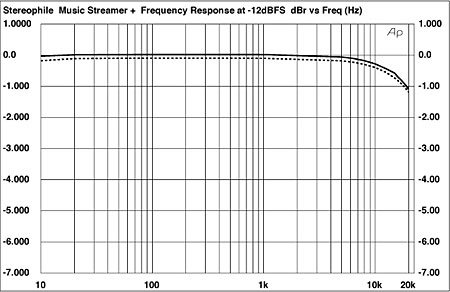
Fig.1 HRT Music Streamer+, frequency response at –12dBFS into 100k ohms, 44.1kHz data (right channel dashed; 1dB/vertical div.).
To maintain consistency with the reviews of digital products I have published over the past 20 years, my primary test of resolution is to sweep a 1/3-octave bandpass filter from 20kHz to 20Hz while the device under test decodes dithered data representing a 1kHz tone at –90dBFS. The resultant spectral analysis for the Music Streamer+ is shown in fig.2: While the noise floor is respectably low, a small degree of positive linearity error is evident, as is quite a large amount of second-harmonic distortion. Both these facts were confirmed by FFT analysis (fig.3), and by looking at the amplitude of a 500Hz tone as it dropped from –60dBFS to –120dBFS (fig.4). While the Streamer+ will output audio when fed 24-bit data, repeating these analyses (not shown) indicated that the DAC simply truncates the 24-bit data to 16, which introduces distortion and quantizing errors.
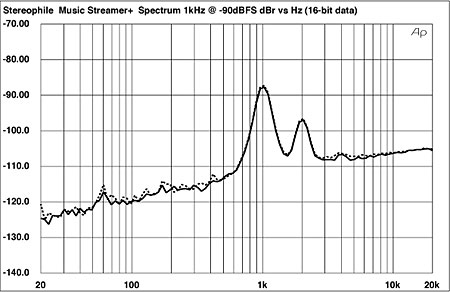
Fig.2 HRT Music Streamer+, 1/3-octave spectrum with noise and spuriae of dithered 1kHz tone at –90dBFS, 16-bit data (right channel dashed.)
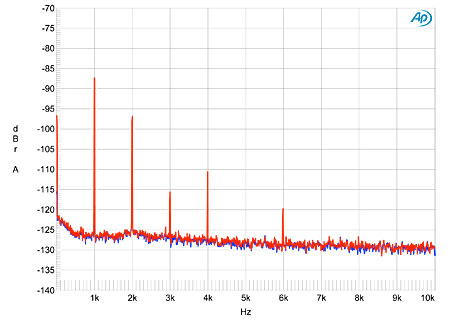
Fig.3 HRT Music Streamer+, FFT-derived spectrum with noise and spuriae of dithered 1kHz tone at –90dBFS, 16-bit data (left channel blue, right red).
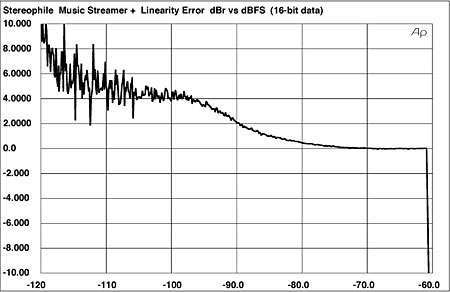
Fig.4 HRT Music Streamer+, left-channel linearity error, 16-bit data (2dB/vertical div.).
Feeding the Music Streamer+ with undithered 16-bit data representing a tone at exactly –90.31dBFS revealed that the reason for the linearity error and the second-harmonic distortion was a significant degree of waveform asymmetry, where a +1LSB change produced a much larger change in voltage than a –1LSB change (fig.5). (For an example of excellent performance on this test, from Cambridge Audio's Azur DacMagic, see fig.6 here.)
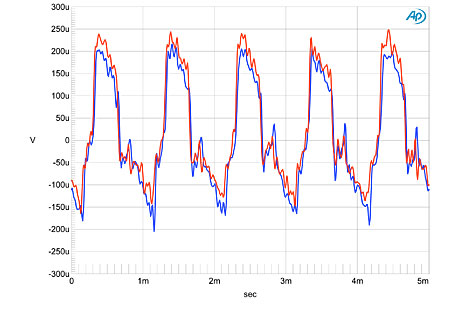
Fig.5 HRT Music Streamer+, waveform of undithered 1kHz sinewave at –90.31dBFS, 16-bit data (left channel blue, right red).
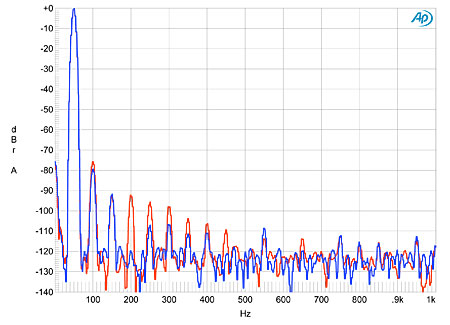
Fig.6 HRT Music Streamer+, spectrum of 50Hz sinewave at 0dBFS into 600 ohms, 16-bit data (left channel blue, right red; linear frequency scale).
The Streamer+'s output stage produced moderately low levels of harmonic distortion, even into the demanding 600-ohm load (fig.6), with the subjectively benign second and third harmonics dominating. The right channel (red trace) had significantly more higher-order harmonics visible than the left (blue). However, the performance of the Streamer+ was somewhat disappointing on the high-frequency intermodulation test (fig.7); a large number of high-order spuriae were visible, and the intermodulation products at 18 and 21kHz lay at just above –60dB (0.1%).
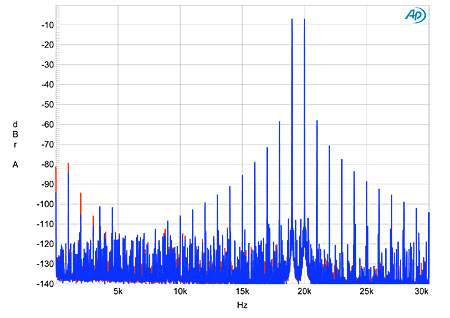
Fig.7 HRT Music Streamer+, HF intermodulation spectrum, 19+20kHz at 0dBFS peak into 100k ohms, 16-bit data (left channel blue, right red; linear frequency scale).
Unlike the "asynchronous" USB DACs from Ayre, dCS, and Wavelength, which use a high-precision master clock adjacent to the DAC to minimize jitter, the PCM2706 used in the Music Streamer+ has to reconstruct the average sample-rate clock from the incoming USB data, in a process called "adaptive isochronous" transmission. Despite Burr-Brown's claims, in the PCM2706's datasheet, for the efficacy of the chip's "SpAct" architecture, this process is inherently prone to jitter because control of the dataflow is handled by the host PC. Fig.8 shows a narrowband spectrum of the Streamer+'s analog output while it decoded the 16-bit Jitter Test tone. Some spreading of the central spike representing the 11.025kHz tone is evident, due to random low-frequency fluctuations in the clock frequency, while several sideband pairs can be seen, as well as a spurious tone of unknown origin at 12.5kHz. The total jitter is around 700 picoseconds peak–peak; while this is not nearly as high as the worst DACs I have measured, it is several times higher than the best.
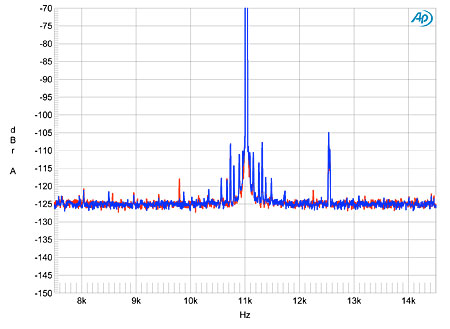
Fig.8 HRT Music Streamer+, high-resolution jitter spectrum of analog output signal, 11.025kHz at –6dBFS, sampled at 44.1kHz with LSB toggled at 229Hz, 16-bit data. Center frequency of trace, 11.025kHz; frequency range, ±3.5kHz (left channel blue, right red).
High Resolution Technologies' Music Streamer+ does offer greater resolution than their basic Music Streamer, but neither offers outstanding measured performance. However, the low prices, particularly of the Streamer, should be borne in mind. The point of these products is not to provide state-of-the-art performance at an affordable price; instead, they are intended to offer enough of what is possible from computer-based audio to act as high-end starting points. One caution is appropriate, however, given that music is now becoming available with bit depths greater than 16: Because the PCM2706 chip used in both Streamers truncates the incoming data to 16 bits, it's possible that playing back 24-bit files will result in worse sound than from 16-bit files.—John Atkinson
- Log in or register to post comments




































